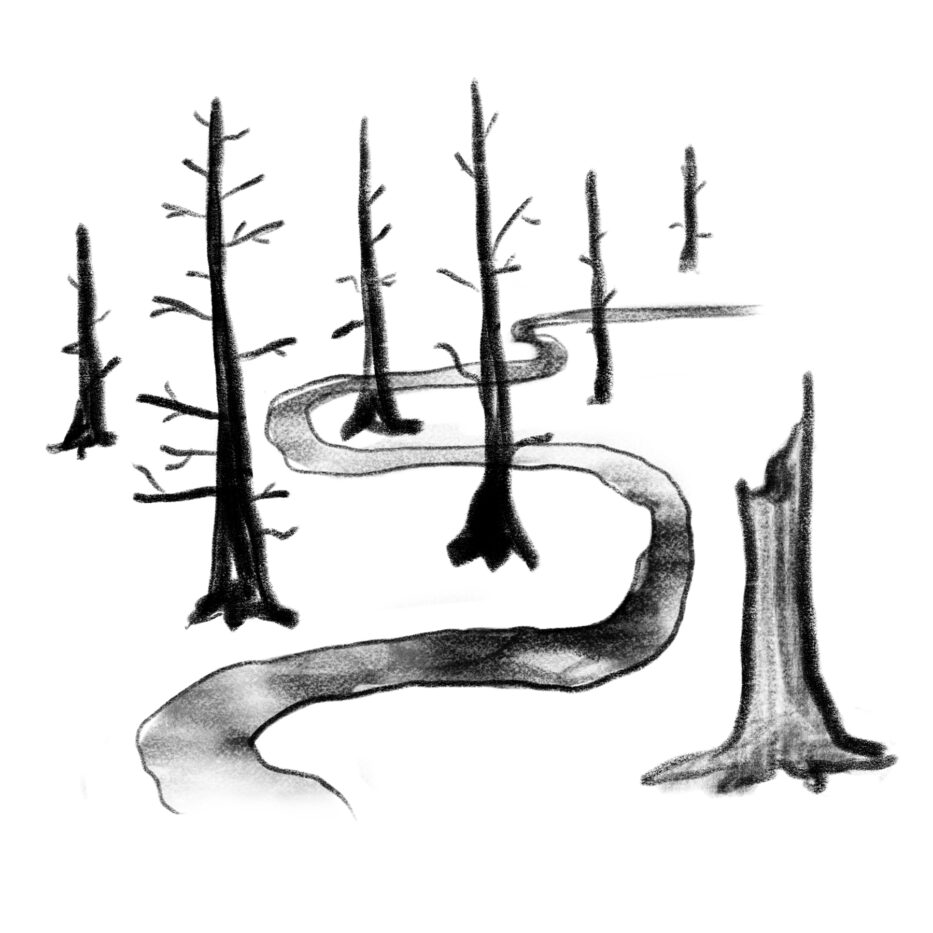
Image by Ivy Sanders Schneider

Image by Ivy Sanders Schneider
Back in the stiff heat of August, I sat with family and friends, on the porch of an old lodge in southwestern New Mexico, where we broached our habitual subjects of fire and water in the American West. Since the rains had arrived mid-June, we ceded our reunion plans to the Gila River — whose channels, by then, were too deep for even jacked-up trucks to cross — but decided anyhow to try fording to our quarters on foot. To the opposite shore we carried suitcases and bottles of bourbon, several pounds of elk meat, an infant, and a crockpot.
Amid relentless drought, such as the one we’re in, a good monsoon season feels like nothing short of mercy. The lot of us had come from all across California and other parched states to take in its spectacle. Whatever logistical hurdles presented by the gorged river, we’d agreed, would be well worth it to see the transformation of the usually brown and sparse vegetation into impossible, temporary lushness. Thick vines climbed the sides of anything they could, rocky parcels turned to meadows fit for grazing, and wildflowers bloomed in purples, reds, ivories. With the constant click of cicadas and the smell of wet earth, too, the arid terrain camouflaged itself as the verdant tangles of a summertime back East.
A few months prior, when the dry seemed impenetrable, the lodge and nearby ranches lay in the path of the Black Fire, which had already devoured more than 300,000 thirsty acres to the east. The blaze fed on timber and brush whose moisture levels were nearly null. If not for an early monsoonal deluge and a lucky shift in wind, the additional structures might have been razed by flames, no matter firefighters’ efforts. “This,” said a fire lookout who’d come down from his tower to join us on the porch that evening, “is bad fire policy in action.”
A lasting effect of “bad fire policy”— a reference to the Forest Service’s mandate, during much of the twentieth century, that all blazes be suppressed — is excess accumulation of the plant life that fuels today’s outsize conflagrations. But the West’s emissions-aided slouch toward aridification doesn’t help, either, and has its own traceable lineage in bureaucratic missteps. Look no further than the continued failure of seven states — Colorado, Wyoming, Utah, New Mexico, Arizona, Nevada, and California — to reach an agreement to save millions of acre-feet of Colorado River water. The disappearing river, which supplies water to 40 million people and large swaths of productive farmland, has long been forsaken to political whim. Its flow is apportioned by an outdated and supposedly unfixable water-rights system that enables priority users — including a handful of Saudi- and Wall Street-backed agricultural behemoths — to divert in massive quantities, regardless of the river’s decline. An estimated 7.5 million acre-feet of water, for example (and some from the Colorado, no doubt), were squandered to produce 1.3 billion pounds of frivolous, for-export almonds that, as of July, were stuck at and around Oakland’s port, due in part to supply-chain bottlenecks.
And what of the repercussions? In California, at least, there are virtually none, since legal favor keeps water flowing. Even Governor Gavin Newsom’s administration — touted as climate-progressive, promising to reduce emissions by phasing out gasoline-powered cars — has responded to drought with reckless deregulation. In a July resignation letter from his post at the State Water Resources Control Board (SWRCB), the presiding body for water allocation to myriad entities and stakeholders, Max Gomberg wrote that it was “gut wrenching” to witness “the agency’s ability to tackle big challenges nearly eviscerated” by Newsom and his entourage.
When he assumed office in 2019, Newsom chose not to reappoint Felicia Marcus, his predecessor Jerry Brown’s pick for SWRCB chair, who, amid the previous drought, advocated for and enacted mandatory water cuts for cities and irrigation districts across the state. Despite shattered climate records and a dismal projection for California’s water future, Newsom continues to dismiss fierce calls to reinstate those universal restrictions. The governor has instead punted responsibility to some 400 local water agencies — each with its own reluctances to incentivize cuts by paying customers — while deploying his usual disruptor-inflected talk (“integration of challenges”) of eventual infrastructure updates.
Still, there’s only so much that a new dam or a sophisticated water-recycling plant can do when water itself is irreparably scant. Perhaps the most effective tool is also the simplest one: to require drastic reduction in water use, particularly by its largest guzzler, the farm sector. Such transformative restrictions would require an unwilling and politically sly Newsom to stand up to an agriculture lobby whose profits and influence are sustained by growing to glut. But at this rate, we’re more likely to see one of the governor’s hazy desalination or controversial tunnel plans before any meaningful curtailment of Big Ag’s overuse.
On the drive back from our gathering in New Mexico, the dense green thinned into occasional smatterings of ocotillo and saguaro before opening up, just beyond Yuma, Arizona, to the towering dunes of the Imperial Valley. The colossal fragility of our water situation is most apparent there, where the narrow All-American Canal bisects miles of sand to make the mirage of abundance possible. Passing the canal this time — a snaking blur out the car window — I grew still, silently cursing the almonds and the alfalfa and the golf courses, and then I bowed my head to pray for rain.
Emma Hager is a writer and editor from California.